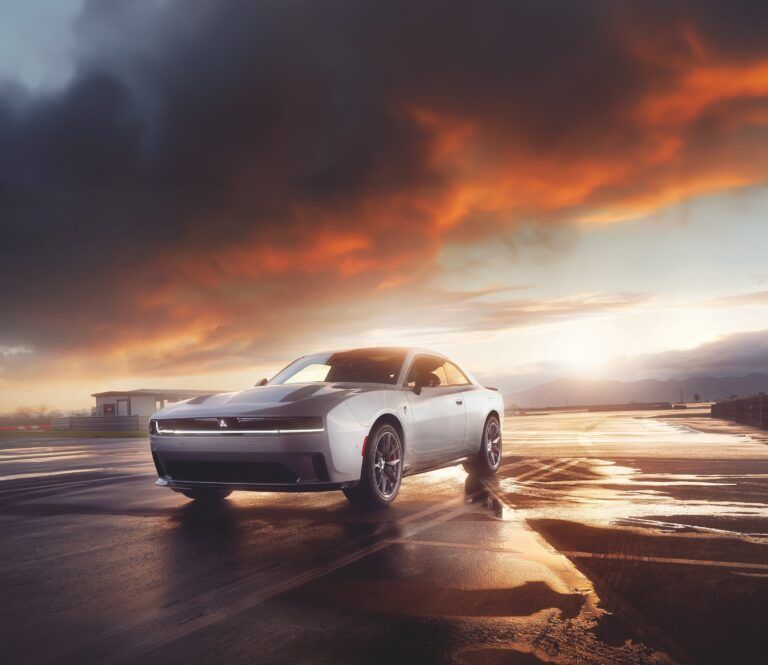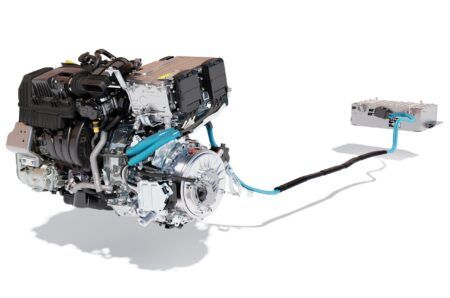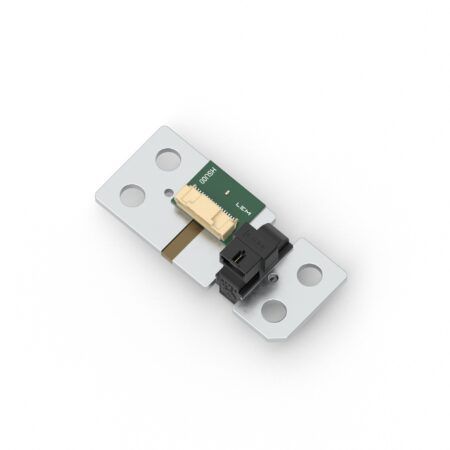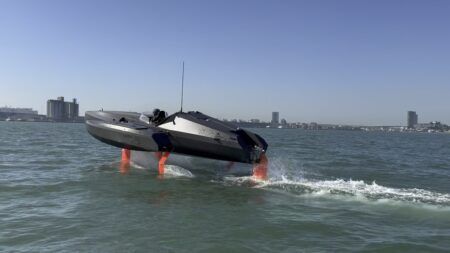How does a brand that’s reputation is based upon brash, noisy, gas-guzzling vehicles move into a more considered, less polluting future? Dodge hope its all-electric vehicle Charger Daytona has the answer.
What would Vin Diesel say? The 124-year-old American automaker (part of the global Stellantis brand), known for high-performance, gas-guzzling, and demonstrably noisy cars and trucks, announced its move into the EV space two years ago with its first concept car. The idea of such an American icon making the transition to electric seemed counterintuitive, yet the promises made by CEO Tim Kuniskis – that the brand would stop producing ICE-powered Charger and Challenger models – are well on their way to being kept. But is the Dodge Charger Daytona still fast, and will it stop fans of the affectionately named ‘muscle car’ being furious?
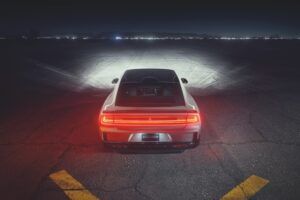
Shooting for power
To start with, the car has a 400-volt system and a 100.5kWh battery capable of producing up to 670 horsepower. Dodge claim it can go from 0-60mph in 3.3 seconds and cover a quarter of a mile in just over 11 seconds. The electrical architecture facilitates relatively quick charging rates: 20-80% in under 30 minutes on a level 3 DV fast charger.
The electric Charger will be available in two trims: R/T and Scat Pack; and there’s a two-door coupe version of each, as well as a four-door sedan. The R/T will put out 456 horsepower, 404lb-ft of torque, with 0-60mph in 4.7 seconds. The Scat Pack will produce 630 horsepower, 627lb-ft of torque, and hit 60mph in 3.3 seconds. Utilizing the brand’s STLA Large platform, the Daytonas have two drive units with 250-kw permanent magnet synchronous motors, one for each axle for standard all-wheel drive. For the initial launch year, both the R/T and Scat Pack will come standard with a Direct Connection upgrade kit from Dodge’s performance parts arm that provides 15-second boosts of an extra 40 hp if you allow 30 seconds between each boost. Dodge brands this the Power Shot, and it’s accessible via a steering wheel button opposite the drive mode button so you don’t have to fiddle with a toggle or touchscreen when you need more power. Next year, the Power Shot kits will cost extra.
Also standard for just the first year is the largest brake package ever offered on a Dodge, consisting of 6-piston Brembo front and 4-piston rear callipers clamping down on 16.0-inch rotors. One-pedal driving is not part of the plan, though paddle shifters enable three levels of regenerative braking. The front drive unit disconnects power to the wheels and improves range and efficiency based on drive mode, while the rear unit has a mechanical limited-slip differential for better traction out of corners.
There are plenty of drive modes, including the standard Auto, Eco, Sport, and Wet / Snow. For the Scat Pack trim, drivers will get two additional drive modes: Track and Drag. Track mode produces “maximum vehicle performance capability on smooth, dry surfaces, while Drag Mode, intended for use on an enclosed dragstrip, provides optimal dragstrip launch and straight-line acceleration.”
All this power has a price though, as the Scat Pack offers a meagre 260 miles of EPA estimated distance, while the R/T fares a little better at 317 miles. But fans of muscle cars shouldn’t be that bothered about the range – how many times do you want to ‘cruise’ the ‘strip’ anyway? What’s more important is how the car looks, and seeing as the Charger Daytona is based upon the first Dodge Challenger from the early 1970s, its EV makeover is predominantly internal. That’s not to say the addition of an electric powertrain hasn’t changed things, but they’re positive advances. For example, the wheels have been moved further to the corners of the car, expanding the passenger area and creating more space for passengers in the back seats. But the design of the Charger Daytona is pure classic muscle car, with a tucked-in nose, a long hood, slab sides, a fastback roofline, and a blunt rear end.
One key characteristic from the 2022 concept car was the R-Wing blade topping the front end. This hollowed-out area at the nose of the car allows airflow to pass through from the grille and onto the hood, providing additional front-end downforce, as well as referencing the original 1968 Daytona Charger. Although the 23-inch rear tail wing from that iteration is conspicuous by its absence.
For those who miss such things, fear not. Although the car has all-wheel drive, onboard technology means that rear-wheel burnouts and donuts can still be performed.
Rather than be a contradiction in terms, the Dodge Charger Daytona shows how the tradition values of the ICE age can still be present, and indeed celebrated, in an EV future. But don’t think this embracing of progressive technology means that Dodge are going soft. As to reinforce its macho credentials, the marque has already announced that it doesn’t consider itself as a company that sells electric versions of their vehicles. What Didge sells is “eMuscle.” Vin Diesel would be proud – although he may want to think about changing his name to keep up.
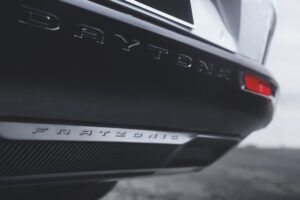 Spirit of the Charger
Spirit of the Charger
When it comes to muscle cars, looks and handling are only part of the experience. Another crucial factor is how the car sounds. The distinctive Dodge noise for many is the very essence of American muscle cars and without it, well, it’s just not the same.
Dodge have met this challenge head on. Like all EVs, the Charger Daytona emits a low hum to keep pedestrians safe in car parks, but as the RPMs rise, so too does the noise, generated but something called a Fratzonic Chambered Exhaust System. Basically, a sound system stored beneath the car, this complex system is designed to deliver an authentic and multi-dimensional muscle-car sensory experience. At its core are internal speakers and woofers that send sound vibrations into mixing chambers stored beneath the rear bumper. It’s these chambers that make the difference as, even though the noise is digital, it is processed analogue, giving it a natural quality. In addition to this force generators create vibrations in time with the faux engine noise. The whole thing aims to make driving the Charger Daytona as tactile an experience as getting behind the wheel of an ICE model.


